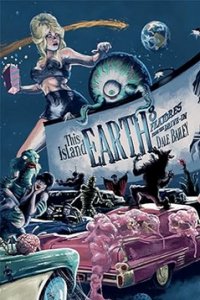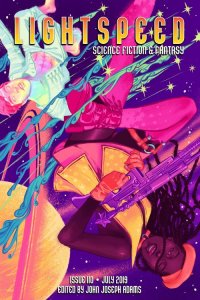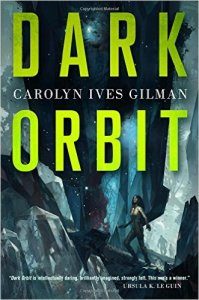Paul Di Filippo Reviews This Island Earth by Dale Bailey
 This Island Earth: 8 Features from the Drive-In, Dale Bailey (PS Publishing 978-1786368973, hardcover, 266pp, $36.00) April 2023
This Island Earth: 8 Features from the Drive-In, Dale Bailey (PS Publishing 978-1786368973, hardcover, 266pp, $36.00) April 2023
When I first became lucky enough to find a publisher for my early story collections—the much-missed Four Walls Eight Windows, under John Oakes—I decided to make each volume a thematic assemblage. I had by then accumulated enough stories with prior magazine appearances to make such picking and choosing possible. The Steampunk Trilogy: well, obviously all steampunk tales; three novellas in fact. Ribofunk: all near-future tales of bio-engineering. Lost Pages: alternate histories with a bevy of real-life writers as protagonists. Fractal Paisleys: the gonzo, comedic stuff. But after a while, I ran out of suites of stories that all resonated to the same theme, and so my collections became generalized, with a little of everything between the boards. I like this latter type of story collection quite well. But I have to admit that the early books—with their internal organic cohesion—felt a little special.
I offer this bit of personal history just to show that I love such thematically unified books and am always on the lookout for this fairly rare kind of single-author outing. And so I am thrilled to report that Dale Bailey’s latest offering is just such a book, and among the best such that I have ever encountered. Its selections stand out individually as deft, clever, and touching examples of his chosen theme; and they also work together to wonderful cumulative effect. The book as a whole is a small masterpiece—especially when one considers that it pays homage to a sub-genre of fantastika that has a reputation as schlock: the low-budget horror/SF films of the 1950s.
In a very charming and thoughtful autobiographical preface, Bailey relates how as a kid he was fascinated by such films, but how—in a pre-VHS, pre-digital, pre-streaming era—he also lacked full access to them, thus being forced to conjure up in his imagination what they were all about. This “misprisioning” (to use a Clutian critical term) results in delightfully lateral interpretations that fuel these fictions. Somehow, Bailey intuited the core meanings of such films, but is not constrained by many viewings to an all-too-literal pastiche of each title. He uses the armature and tropes of these movies to deliver deep humanist parables.
But before we dive into these creative tributes, allow me to praise the artist Ilan Sheady, whose vibrant, overstuffed wraparound cover and witty interior illustrations are a perfect complement to Bailey’s narratives. The sheer physical attractiveness of this book is a tribute to the folks at PS Publishing and their labors of love.
We open with “I Married a Monster from Outer Space”. Wal-Mart worker Ruth encounters a giant alien approaching her cash register, and does not flinch. Through charity and compassion, she brings the fellow home. Dubbed Gort by Ruth’s partner Donny, the creature seems placid and content, though with an undercurrent of melancholy. And why not, since Gort’s saucer lies crashed and inoperative nearby? Can Donny get the craft up and running? And will Gort’s probable departure ruin Ruth’s life, or enhance it?
Most of the tales herein exhibit a certain gravitas and reside towards the tragic end of the literary spectrum. But “I Was a Teenage Werewolf” is sheer unrepentant splatterpunk. At first a high school is plagued with a few odd murders and the possibility of a lone werewolf among the student body. But when the werewolf plague becomes dominant, it’s a different pile of entrails. I was reminded of Kit Reed’s great story about a pack of feral Girl Scouts.
“The Horror of Party Beach”, rich with the cultural talismans of the 1950s, finds our teenage narrator falling in love with an eccentric outcast girl named Elaine. But Elaine starts to manifest certain, ah, Lovecraftian traits which eventually bring their love affair to a calamitous end.
“Night Caller from Outer Space” might be my fave entry. It is as subtle and beautifully ambiguous as “Teenage Werewolf” is in-your-face. Our hero, Ezra, a radio DJ, has had the misfortune to watch his lover Abby be abducted by saucer creatures. The reader learns this upfront, and the rest of this longish story is a meditation on how Ezra deals with this loss, and whether he can ever attain closure.
If you were to strip Bailey’s name from the next tale, “The Creature from the Black Lagoon”, and hand the manuscript to a knowledgeable fan, they might very well suspect Howard Waldrop to be the author, and that’s high praise indeed. As we follow the career of the literal Creature when it is co-opted by Hollywood, we find ourselves in a topsy-turvy scenario where the Creature’s humanity trumps that of the actual humans.
In “Invasion of the Saucer Men”, we learn at the get-go that “Teenagers had been foiling alien invasions for months by then.” Embracing the weird conventions of such films, Bailey has his meat-headed protagonist Hank reacting to six ETs in a most ham-handed way.
“Teenagers from Outer Space” deploys that great trope of an alien ghetto on Earth forced to integrate with humans. The sapients of Bug Town, derided and harassed, nonetheless display a certain nobility that attracts a girl named Joan—to the dismay of her narrator boyfriend.
Finally, “The Ghoul Goes West” shows us a man investigating the death of his Hollywood-besotted brother, and following a trail of associations that lead straight to the counterfactual late-in-life career of Bela Lugosi.
All of these stories, as full of stefnal and horror tropes as they are, exhibit a beautiful, poetic naturalism couched in elegant, understated prose. In a tale like “Night Caller from Outer Space” for instance, we can inhabit the down-and-out textures of Ezra’s life in vivid realism. Bailey has deep empathy for all his characters, and this rich humanism transcends the often-silly original material of the template films.
Anyone looking to fashion silk purses out of sows’ ears could take a lesson from this exuberant collection that raises its inspirational material to a much higher literary plane, without denying the power and allure of the originals.
 While you are here, please take a moment to support Locus with a one-time or recurring donation. We rely on reader donations to keep the magazine and site going, and would like to keep the site paywall free, but WE NEED YOUR FINANCIAL SUPPORT to continue quality coverage of the science fiction and fantasy field.
While you are here, please take a moment to support Locus with a one-time or recurring donation. We rely on reader donations to keep the magazine and site going, and would like to keep the site paywall free, but WE NEED YOUR FINANCIAL SUPPORT to continue quality coverage of the science fiction and fantasy field.
©Locus Magazine. Copyrighted material may not be republished without permission of LSFF.








Really glad you like the artwork. This cover was the largest piece I’ve ever work on but I loved every second due to the love I have for that cinematic era. Bailey is an incredible writer so it’s extra nice to see my work get a mention. Thank you so much.